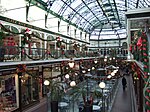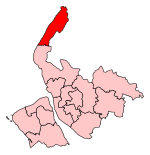Lord Street, Southport
England road stubsShopping streets in EnglandSouthportStreets in MerseysideTourist attractions in Merseyside ... and 1 more
Use British English from January 2018

Lord Street is the main shopping street of Southport, in Merseyside. It is 1 mile (1.6 km) long, with a roundabout marking each end of the street. There are many water features, gardens and architectural buildings along the entire street, with a mix of residential, commercial and public buildings. It was laid out in the early 19th century. Southport Lord Street railway station, which opened on 1 September 1884, was the terminus of the Southport and Cheshire Lines Extension Railway. Although it closed to passengers in 1952, the frontage of the building was retained.
Excerpt from the Wikipedia article Lord Street, Southport (License: CC BY-SA 3.0, Authors, Images).Lord Street, Southport
Lord Street,
Geographical coordinates (GPS) Address Phone number Website Nearby Places Show on map
Geographical coordinates (GPS)
| Latitude | Longitude |
|---|---|
| N 53.648 ° | E -3.006 ° |
Address
Crave Pizza
Lord Street 110a
PR8 1JR
England, United Kingdom
Open on Google Maps










